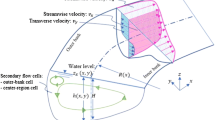Abstract
The concept of vortex is crucial in both understanding and modeling of turbulence. For large eddy simulation (LES), the effect of small-scale eddies onto the large scales or the resolved flow field is modeled by subgrid stress models. Even though the rotating motions of fluids, i.e., vortices or eddies are central in developing turbulent models, vortex identification methods are seldom used in these models. In this study, we develop a new subgrid model based on the Liutex vector, a new quantity introduced to decompose fluid motions into rigid rotation, pure shear and stretching, and thus identify vortices. The new model is then applied in a decaying homogeneous isotropic turbulence (DHIT) and a turbulent channel flow at Reynolds number Reτ = 180. It is shown that the new model can predict accurate energy spectra compared with experiments in DHIT and give a well-matched velocity profile in turbulent channel flow without changing the form of the model. Future directions include improvement of the Liutex based model, for example developing anisotropic subgrid models, and its applications in various turbulent flows.
Similar content being viewed by others
References
Liu C., Gao Y., Tian S. et al. Rortex—A new vortex vector definition and vorticity tensor and vector decompositions [J]. Physics of Fluids, 2018, 30(3): 035103.
Liu C., Gao Y. S., Dong X. R. et al. Third generation of vortex identification methods: Omega and Liutex/Rortex based systems [J]. Journal of Hydrodynamics, 2019, 31(2): 205–223.
Wang Y. Q., Gao Y. S., Xu H. et al. Liutex theoretical system and six core elements of vortex identification [J]. Journal of Hydrodynamics, 2020, 32(2): 197–211.
Wang Y. Q., Gao Y. S., Liu J. M. et al. Explicit formula for the Liutex vector and physical meaning of vorticity based on the Liutex-Shear decomposition [J]. Journal of Hydrodynamics, 2019, 31(3): 464–474.
Kolář V., Šístek J. Stretching response of Rortex and other vortex-identification schemes [J]. AIP Advances, 2019, 9: 105025.
Liu J., Gao Y., Liu C. An objective version of the Rortex vector for vortex identification [J]. Physics of Fluids, 2019, 31(6): 065112.
Dong X., Gao Y., Liu C. New normalized Rortex/vortex identification method [J]. Physics of Fluids, 2019, 31(1): 011701.
Liu J., Liu C. Modified normalized Rortex/vortex identification method [J]. Physics of Fluids, 2019, 31(6): 061704.
Gao Y. S., Liu J. M., Yu Y. et al. A Liutex based definition and identification of vortex core center lines [J]. Journal of Hydrodynamics, 2019, 31(3): 445–454.
Xu H., Cai X. S., Liu C. Liutex (vortex) core definition and automatic identification for turbulence vortex strucutres [J]. Journal of Hydrodynamics, 2019, 31(5): 857–863.
Gui N., Ge L., Cheng P. X. et al. Comparative assessment and analysis of Rortex vortex in swirling jets [J]. Journal of Hydrodynamics, 2019, 31(3): 495–503.
Zhang Y., Liu K. H., Li J. W. et al. Analysis of the vortices in the inner flow of reversible pump turbine with the new omega vortex identification method [J]. Journal of Hydrodynamics, 2018, 30(3): 463–469.
Liu C. New ideas on governing equations of fliud dynamics [J]. Journal of Hydrodynamics, 2021, 33(4): 861–866.
Liu C., Liu Z. New governing equations for fluid dynamics [J]. AIP Advances, 2021, 11: 115025.
Xu W. Q., Wang Y. Q., Gao Y. S. et al. Liutex similarity in turbulent boundary layer [J]. Journal of Hydrodynamics, 2019, 31(6): 1259–1262.
Xu W., Wang Y., Gao Y. et al. Observation on Liutex similarity in the dissipation subrange of turbulent boundary layer [J]. Computers and Fluids, 2022, 246(4): 105613.
Smagorinsky J. General circulation experiments with the primitive equations: I. The basic equations [J]. Monthly Weather Review, 1963, 91: 99–164.
Moin P., Kim J. Numerical investigation of turbuelnt channel flow [J]. Journal of Fluid Mechanics, 1981, 118: 341–377.
Nicoud F., Ducros F. Subgrid-scale stress modelling based on the square of the velocity gradient tensor [J]. Flow, Turbulence and Combustion, 1999, 62: 183–200.
Comte-Bellot G., Corrsin S. Simple Eulerian time correlation of full- and narrow-band velocity signals in grid-generated, ‘isotropic’ turbulence [J]. Journal of Fluid Mechanics, 1971, 48(2): 273–337.
Laizet S., Lamballais E. High-order compact schemes for incompressible flows: A simple and efficient method with the quasi-spectral accuracy [J]. Journal of Computational Physics, 2009, 228(15): 5989–6015.
Author information
Authors and Affiliations
Corresponding author
Additional information
Compliance with Ethical Standards
Conflict of Interest: The authors declare that they have no conflict of interest.
Informed consent: Informed consent was obtained from all individual participants included in the study.
Ethical approval: This article does not contain any studies with human participants or animals performed by any of the authors.
Project supported by the National Science Foundation of the Jiangsu Higher Education Institutions of China (Grant No. 22KJB130011), the Supercomputing Center in Yancheng (Grant No. FW(W)20221001).
Biography: Yuan Ding (1997-), Female, Master Candidate, E-mail: 1664242988@qq.com
Rights and permissions
About this article
Cite this article
Ding, Y., Pang, By., Yan, Bw. et al. A Liutex-based subgrid stress model for large-eddy simulation. J Hydrodyn 34, 1145–1150 (2022). https://doi.org/10.1007/s42241-023-0085-0
Received:
Revised:
Accepted:
Published:
Issue Date:
DOI: https://doi.org/10.1007/s42241-023-0085-0




